Gross domestic product grew in July to September, exports and consumption increased
In the July to September period, the seasonally adjusted volume of Finland’s gross domestic product increased by 0.8 per cent from the previous quarter. GDP adjusted for working days grew by 4.2 per cent compared to the third quarter of 2020. Examined at current prices, gross domestic product adjusted for working days was 7.7 per cent higher than one year ago.
Figure 1. Volume change of GDP from the previous quarter, seasonally adjusted, per cent
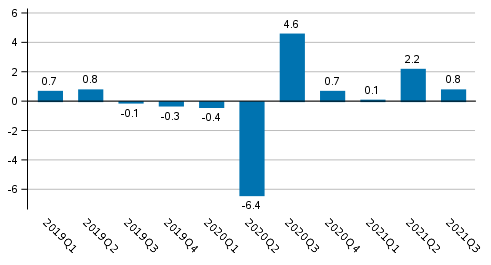
According to preliminary data compiled by Eurostat, gross domestic product in the EU area increased by 2.1 per cent in the third quarter compared to the previous quarter.
The national economy continued to grow in the third quarter of 2021. Finland’s gross domestic product reached the level prior to the corona crisis already in the second quarter, when the economy still grew by over two per cent. In the July to September period, GDP growth remained at under one per cent.
Output
The volume of total value added generated by all industries grew by 0.8 per cent from the previous quarter and by 4.4 per cent year-on-year.
Figure 2. Year-on-year changes in the volume of value added generated by industries in the third quarter of 2021, working day adjusted, per cent
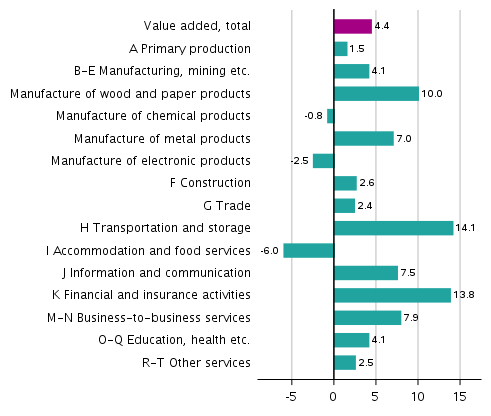
Figure 3. Changes in the volume of value added generated by industries in the third quarter of 2021 compared to the previous quarter, seasonally adjusted, per cent
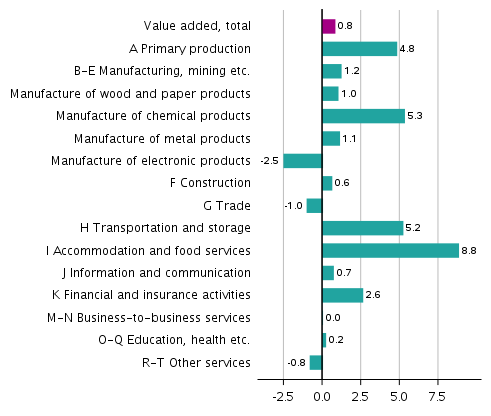
In primary production, that is, agriculture, forestry and fishing, the volume of value added grew in July to September compared with both the previous quarter and the year before. Agriculture and hunting declined but strong growth in forestry pushed total primary production up by five per cent from the previous quarter.
The volume of value added in manufacturing industries (incl. mining and quarrying and energy supply, water supply and waste management) grew in July to September. In the third quarter of 2021, prices of several industrial products rose clearly, which is visible in that value added at current prices grew considerably more than volume change. The forest and metal industries grew. The chemical industries made an upturn from the previous quarter but were lower than one year ago. The electrical and electronics industry contracted both from the previous quarter and from one year back. Construction continued to grow in July to September.
Service industries grew in the third quarter of 2021. Trade industries turned to a decline compared with the previous quarter. The industries of information and communication have fared relatively well in the corona crisis and they continued to grow in the third quarter. The industries of transport and accommodation and food service activities that suffered significantly from the corona crisis grew compared with the previous quarter, but their situation is still weak compared with the period prior to the corona pandemic.
Imports, exports, consumption and investments
In July to September, total demand grew by 2.0 per cent from the previous quarter. Exports and consumption increased but investments decreased.
Figure 4. Year-on-year changes in the volume of main supply and demand items in the third quarter of 2021, working day adjusted, per cent
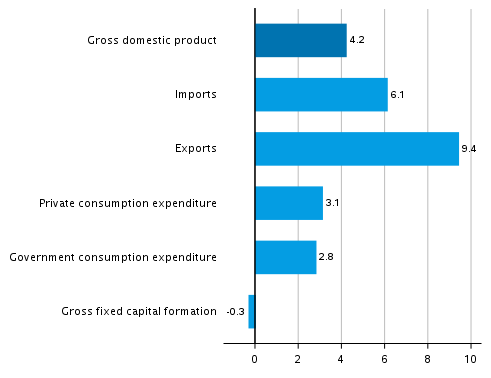
Figure 5. Changes in the volume of main supply and demand items in the third quarter of 2021 compared to the previous quarter, seasonally adjusted, per cent
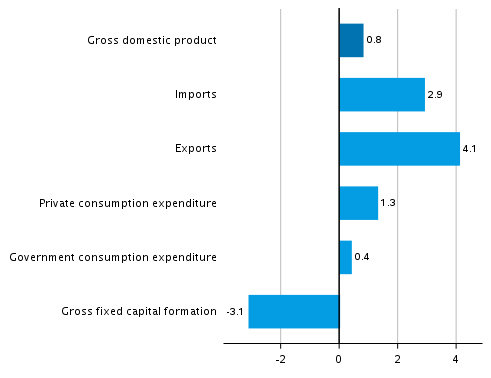
From July to September, the volume of exports increased by four per cent from the previous quarter. The volume of both goods and services exports was growing. Compared to one year ago, exports increased by as much as nine per cent. Imports increased by three per cent from the previous quarter and by six per cent year-on-year. Prices of international trade in goods rose briskly in the third quarter because compared with one year ago, the value of both goods exports and imports grew considerably more when viewed at current prices than as volume. Exports of goods grew by 28 per cent at current prices year-on-year but volume change remained at eight per cent. The export and import prices of services were also growing.
Private consumption grew in July to September. However, the growth was no longer as strong as in the second quarter. Household consumption expenditure in services and semi-durable goods increased clearly. In contrast, consumption expenditure on durable goods contracted. The consumption of non-durable goods grew year-on-year but diminished from the previous quarter. Government consumption expenditure increased.
Gross fixed capital formation, or investments, fell from the previous quarter. Public investments decreased both relative to the previous quarter and from one year back. Private investments still grew year-on-year but started were down from the previous quarter. Investments in residential buildings still grew in the third quarter. Investments in other building construction and civil engineering fell. Investments in machinery, equipment and transport equipment decreased. This was considerably affected by sales abroad recorded as a negative investment related to investments in transport equipment. In July to September, investments in research and development and software increased slightly. According to revised data, investments in research and development and software have developed more favourably than previously estimated in the first two quarters of 2021.
Employment, wages and salaries and national income
In July to September, the number of employed persons grew by 2.1 per cent and that of hours worked by 1.2 per cent year-on-year. From the previous quarter, the number of hours worked grew by 0.5 per cent.
In the July to September period, the nominal wages and salaries bill of the national economy grew by 1.9 per cent from the previous quarter and by 6.2 per cent year-on-year. Social contributions paid by employers went up by 22 per cent year-on-year and by 5.1 per cent from the previous quarter. The big year-on-year change is due to a temporary relief made to them in 2020.
The operating surplus (net), which in business bookkeeping corresponds roughly with operating profit, grew in the third quarter by 9.5 per cent year-on-year. Gross national income calculated at current prices was 8.6 per cent higher year-on-year.
The available data
These preliminary quarterly data are based on the source information on economic development that had become available by 25 November 2021. The annual level data for 1990 to 2020 correspond with the National Accounts data released on 17 September 2021, except for those on the rest of the world sector (imports, exports, primary income from/to the rest of the world), which may have become revised. The annual data for 2019 to 2020 will be revised on 17 December 2021, when the quarterly accounts database tables will also be updated.
Data concerning the fourth quarter of 2021 will be released on 28 February 2022. A flash estimate on GDP development for October to December will be released in connection within the December data of the Trend Indicator of Output on 15 February 2022.
Due to the benchmarking and seasonal adjustment methods, quarterly data may become slightly revised in connection with each release. However, the largest revisions take place during the two to three years following the release on a quarter, because final annual accounts data are published at a lag of around two years from the end of the statistical reference year. Seasonally adjusted and trend time series always become revised against new observations irrespective of whether the original time series becomes revised or not.
The quality description can be accessed at (in Finnish): http://www.tilastokeskus.fi/til/ntp/laa.html .
Methodological description of Quarterly National Accounts.Source: National Accounts 2021, 3rd quarter. Statistics Finland
Inquiries: Samu Hakala 029 551 3756, Eljas Tuomaala 029 551 2723, kansantalous.suhdanteet@stat.fi
Head of Department in charge: Katri Kaaja
Updated 30.11.2021
Official Statistics of Finland (OSF):
Quarterly national accounts [e-publication].
ISSN=1797-9765. 3rd quarter 2021,
Gross domestic product grew in July to September, exports and consumption increased
. Helsinki: Statistics Finland [referred: 14.12.2025].
Access method: http://stat.fi/til/ntp/2021/03/ntp_2021_03_2021-11-30_kat_001_en.html

